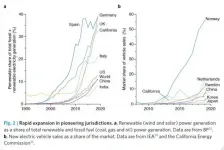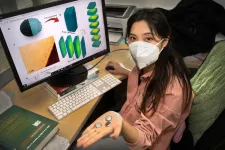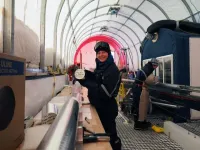(Press-News.org) At the upcoming Conference of the Parties (COP26) in November, ample discussion is likely to focus on how the world is not on track to meet the Paris Agreement's goals of stopping warming at well below 2°C. According to a new University of California San Diego article published in Nature Energy, world diplomats will, however, find encouraging signs in emerging clean energy technology "niches"--countries, states or corporations--that are pioneering decarbonization.
"In certain areas, adoption rates for solar and wind turbines, as well as electric vehicles are very high and increasing every year," write the authors of the opinion piece Ryan Hanna, assistant research scientist at UC San Diego's Center for Energy Research and David G. Victor, professor of industrial innovation at UC San Diego's School of Global Policy and Strategy. "It's important to look to niches because this is where the real leg work of decarbonization is happening. In fact, one can think about the entire challenge of decarbonizing as one of opening and growing niches--for new technologies, policies and practices, which are all needed to address the climate crisis."
The glimmers of hope for decarbonization will be critical for diplomats at COP26, who may be set for disappointment as they begin an official "stocktaking" process of reviewing past emissions. This year, each country will report on emissions accounting for the last five years and issue new, bolder pledges to cut greenhouse gasses.
Prior to the COVID-19 pandemic, global fossil fuel emissions had been rising at about one percent per year over the previous decade. Over that same time, U.S. fossil fuel emissions fell by about one percent per year; however, that slight dip is nowhere near the decline written into the U.S.'s original pledge to the Paris Agreement.
"The abundant talk in recent years about 'the energy transition' has barely nudged dependence on conventional fossil fuels, nor has it much altered the trajectory of CO2 emissions or put the world on track to meet Paris goals," write Hanna and Victor. "Instead, policymakers should measure the real engine rooms of technological change--to niche markets."
They point to a growing number of markets where clean technology is being deployed at rates far above global and regional averages.
"Norway and California are leading on electric vehicles, Ireland on wind power and China on electric buses and new nuclear," write Hanna and Victor.
Today's pioneers in energy are those who are actually doing the hard work of creating low-carbon technologies and getting them out into the world. These leaders developing and trialing new technologies are typically small groups; however, they are critical to the climate change crises because they take on risk and reveal what is possible, thereby lowering the risk for global markets to follow.
For example, beginning in 2010, Germany launched a massive investment in solar photovoltaics, which pushed down costs, making photovoltaics more politically and economically viable around the globe. Hanna and Victor credit Germany's leadership for the expansive photovoltaic market the world has today.
Still, eliminating at least one-third of global emissions will require technologies that are, at this time, prototypes. To get more clean energy technologies deployed on a global scale requires new investments in research and development (R&D), notably in novel technologies related to electric power grids.
These investments are strong in China, mixed in Europe and are lagging along with other R&D expenditures in the U.S.
"In the U.S., a new administration serious about climate change may allow for renewed pulses of spending on R&D-for example, through a prospective infrastructure bill that could gain legislative approval this autumn-as innovation is one of the few areas of energy policy bipartisan consensus," the authors write.
The need is dire, as limiting warming to 1.5°C, per the Paris Agreement, has become increasingly out of reach. Meeting the goal now requires continuous reductions in emissions of about 6 percent annually across the whole globe.
"That is a speed and scope on par with what was delivered by global pandemic lockdowns, but previously unprecedented in history and far outside the realm of what's practical," write the authors.
They conclude that COP26, if handled by diplomats thinking like revolutionaries and not a diplomatic committee, is an opportunity to start taking stock of the industrial and agricultural revolutions that will be needed for decarbonization.
INFORMATION:
TAMPA, Fla. -- There are several new treatment options available for patients with advanced melanoma. While these therapies have greatly improved the prognosis for patients, each person can respond to the treatments differently. Treatment of melanomas that have spread to the central nervous system is especially challenging. In a new article published in Clinical Cancer Research, Moffitt Cancer Center researchers reveal how different therapies impact the surrounding immune environment of metastatic melanoma tumors according to location and identify a rare population of immune cells that is associated with improved overall survival.
Different types of cancer tend to spread to specific sites throughout the body. Common sites of melanoma ...
The pros make it look easy, but making a movie with a drone can be anything but.
First, it takes skill to fly the often expensive pieces of equipment smoothly and without crashing. And once you've mastered flying, there are camera angles, panning speeds, trajectories and flight paths to plan.
With all the sensors and processing power onboard a drone and embedded in its camera, there must be a better way to capture the perfect shot.
"Sometimes you just want to tell the drone to make an exciting video," said Rogerio Bonatti, a Ph.D. candidate in Carnegie Mellon University's Robotics Institute.
Bonatti was part ...
North Carolina State University researchers have developed a computer simulation tool to predict when and where pests and diseases will attack crops or forests, and also test when to apply pesticides or other management strategies to contain them.
"It's like having a bunch of different Earths to experiment on to test how something will work before spending the time, money and effort to do it," said the study's lead author Chris Jones, research scholar at North Carolina State University's Center for Geospatial Analytics.
In the journal Frontiers in Ecology and the Environment, researchers reported on their efforts to develop and test ...
KINGSTON, R.I. - June 3, 2021 - Scientists from the University of Rhode Island have taken the first steps toward understanding the function of microbes that live on and in Eastern oysters, which may have implications for oyster health and the management of oyster reefs and aquaculture facilities.
"Marine invertebrates like oysters, corals and sponges have a very active microbiome that could potentially play a role in the function of the organism itself," said Ying Zhang, URI associate professor of cell and molecular biology. "We know very little about whether there are resident microbes in oysters, and if there are, what their function may be or how they may help or bring harm to the oyster."
Zhang and doctoral student Zachary Pimentel extracted the DNA of microbes living in ...
ANN ARBOR, Mich. -- A different type of surge may be on the way more than a year into the pandemic - a baby surge.
The COVID-19 shutdown initially seemed to hit pause on pregnancy and birth rates, new research from one major hospital system suggests, but that trend is quickly reversing.
"Birth rates declined early on in the pandemic, but we expect a dramatic rebound soon," says lead author Molly Stout, M.D., MSci, maternal fetal medicine director at Michigan Medicine Von Voigtlander Women's Hospital.
"We're already seeing signs of a summer baby surge."
While infectious ...
UPTON, NY--A team of researchers led by chemists at the U.S. Department of Energy's (DOE) Brookhaven National Laboratory has studied an elusive property in cathode materials, called a valence gradient, to understand its effect on battery performance. The findings, published in Nature Communications, demonstrated that the valence gradient can serve as a new approach for stabilizing the structure of high-nickel-content cathodes against degradation and safety issues.
High-nickel-content cathodes have captured the attention of scientists for their high capacity, a chemical property that could power electric vehicles over much longer distances than current batteries support. Unfortunately, the high nickel content also causes these cathode materials to degrade more quickly, creating cracks ...
The South Pole and the rest of East Antarctica is cold now and was even more frigid during the most recent ice age around 20,000 years ago -- but not quite as cold as previously believed.
University of Washington glaciologists are co-authors on two papers that analyzed Antarctic ice cores to understand the continent's air temperatures during the most recent glacial period. The results help understand how the region behaves during a major climate transition.
In one paper, an international team of researchers, including three at the UW, analyzed seven ice cores from across West and East Antarctica. The results published June 3 in Science show warmer ice age temperatures in the eastern part of the continent.
The team ...
Scientists have gained the best view yet of the brightest explosions in the universe: A specialised observatory in Namibia has recorded the most energetic radiation and longest gamma-ray afterglow of a so-called gamma-ray burst (GRB) to date. The observations with the High Energy Stereoscopic System (H.E.S.S.) challenge the established idea of how gamma-rays are produced in these colossal stellar explosions which are the birth cries of black holes, as the international team reports in the journal Science.
"Gamma-ray bursts are bright X-ray and gamma-ray flashes observed in the sky, emitted by distant extragalactic sources," explains DESY scientist Sylvia Zhu, one of the authors of the ...
The biggest shark attack in history did not involve humans.
A new study by Earth scientists from Yale and the College of the Atlantic has turned up a massive die-off of sharks roughly 19 million years ago. It came at a period in history when there were more than 10 times more sharks patrolling the world's oceans than there are today.
For now, researchers don't know the cause of the shark die-off.
"We happened upon this extinction almost by accident," said Elizabeth Sibert, a Hutchinson postdoctoral associate in Yale's Department of Earth and Planetary Sciences and ...
Scientists have developed the first cells that can construct artificial polymers from building blocks that are not found in nature, by following instructions the researchers encoded in their genes.
The study, led by scientists from the Medical Research Council (MRC) Laboratory of Molecular Biology, in Cambridge, UK, also found the synthetic genome made the bacteria entirely resistant to infection by viruses.
The scientists say their research could lead to the development of new polymers - large molecules made of many repeating units, such as proteins, plastics, and many drugs including antibiotics - and make it easier to ...




